|
The traditional
Central Highlands longhouse on edge of extinction
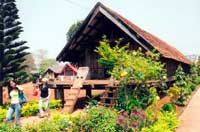
The traditional longhouses of the E De
ethnic minority group are slowly disappearing as the cost of
preserving becomes too much of a burden for their owners,
but there are efforts underway to keep these cultural
treasures around. Ngo Thu Phuong reports.
Visitors to Tay Nguyen (Central
Highlands) should never pass up a chance to stay overnight
in a longhouse, built in the unique architectural style of
the local E De ethnic minority people, as they may not be
around for long.
From the outside, the timber-made house resembles a boat
floating on a river.
Legends surrounding the houses say that the E De people
constructed them in memory of their forefathers, who rowed
boats across the ocean to seek new shelters.
Longhouses are built upon stilts for the practical purpose
of protecting dwellers from floods and dangerous wild
animals, but they are also the stuff of E De oral fables and
fairy tales.
In the story of Dam San, a local hero, the longhouses are
described to be longer than a resounding gong. When people
sitting on the front stairs beat a gong, those sitting on
stairs on the other end canít even hear."
The houses have also been characterised as "so long birds
canít reach the other end without becoming too weary to fly."
According to the Viet Nam Museum of Ethnology in Ha Noi, E
De houses measured 100m long last century, some even spanned
over 200m, but today they have been shortened to 30-40m.
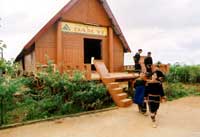 The
head of the cultural management office under the Dac Lac
Culture and Information Department, Truong Bi, said the
houses were constructed from materials available in the
forest, including timber for frame, bamboo for the floor and
walls and reeds for the roof. The
head of the cultural management office under the Dac Lac
Culture and Information Department, Truong Bi, said the
houses were constructed from materials available in the
forest, including timber for frame, bamboo for the floor and
walls and reeds for the roof.
Each house has two doors and two stairs on either end. The
front staircase, used by men only, often has seven steps and
is made from precious timber. The top stair is decorated
with a carved crescent moon and two breasts, symbols of
matriarchal vitality and power.
The stairs on the other end, smaller and simpler, are used
by women, who then can handle the housework in the backyard.
The length of the house indicates the wealth and power of
its owners. The amount of rooms depend on the number of
cohabiting extended family members. The more populous the
family, the more rooms in the house.
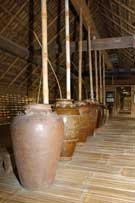 Each
couple and their small children live in a room called an ok,
which is separated from the rest of the house. In a shared
sitting room, called a gah, one to two thirds of the total
surface area, the family places a kípan bench, gong sets and
holds annual family and community festivals. Each
couple and their small children live in a room called an ok,
which is separated from the rest of the house. In a shared
sitting room, called a gah, one to two thirds of the total
surface area, the family places a kípan bench, gong sets and
holds annual family and community festivals.
As the E De people followed a
matriarchal society, traditionally, the house accommodated
the families of daughters and granddaughters, descendants of
one mother. After marriage, a son will reside in his new
wifeís house.
The whole family worked together and shared rice and other
food, but everything was managed by the householdís most
senior woman. Womenís important role in the family is a
special feature of E De society.
The existence of longhouses reflects the ethnic groupís
community spirit.
On the wane
"They (E De traditional houses) are at a risk of
disappearing," cultural researcher Bi said with a sigh.
Sharing his feeling, an official from the Museum of Ethnology , Pham Van Loi lamented, "Itís extremely difficult to preserve the
longhouses. There are not many left."
Though there arenít any statistics on the number of
remaining E De houses, Bi said most have been replaced by
brick, tin or tile-roofed constructions, like those owned by
the Kinh people.
A tour of the region can easily prove his words.
Bi said that out of the total 543 indigenous hamlets in Dac
Lac, two thirds no longer have any traditional houses.
A resident in A Ko Dhong Hamlet in Buon
Ma Thuot City, HíMan Arul, 42, said that since the houses
were made with natural materials, they created a cool
atmosphere for dwellers.
"But brick houses are more comfortable," said Arul, who
lives with her family in a modern house, said. "But, I still
have a small traditional one nearby."
Even her parentís house, considered the longest in the
hamlet, has only two households residing there now.
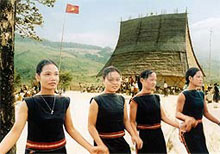 Her
brother, Y Giack Arul, said that his 12 family members used
to live together in the 40m-longhouse. Her
brother, Y Giack Arul, said that his 12 family members used
to live together in the 40m-longhouse.
"As our sisters and brothers grew up and got married, they
moved into separate houses," Y Giack, a well-known singer,
said.
"But I love the crowd in the longhouse. The more crowded it
is, the merrier and warmer the atmosphere. We never felt
like we didnít have any privacy."
Y Giack also said that the high cost of materials and lack
of land area have resulted in the decreasing number of
longhouses in his hometown.
"Itís too sad," he moaned.
The singer has an ambitious plan to make the countryís
longest house, which could measure up to 130m.
But he said he worries he will not be able to find the right
types of timber. Y Giack has therefore started collecting
pillars and furniture from the old houses.
Loi isnít surprised at the changes in E De architecture,
though he doesnít like it.
"Itís inevitable in the modern world that young couples want
to live on their own. New houses are only for the nuclear
family and therefore wonít be long," he said.
Furthermore, an official from the Dac Lac Culture and
Information Depart-ment, Bui Minh Vu, explained the Stateís
prohibition of cutting down the forest has made wood and
other materials rare and more costly than bricks and cement.
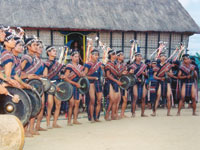 Researcher
Bi fears the problems will result in the loss of their
culture, including customs and rites that celebrate life
cycles, farming life and important activities such as gong
performances and drinking traditional wine from jars through
straws. Researcher
Bi fears the problems will result in the loss of their
culture, including customs and rites that celebrate life
cycles, farming life and important activities such as gong
performances and drinking traditional wine from jars through
straws.
Keeping it alive
Bi said efforts and investments are badly needed from the
province and State to restore the longhouses as a way to
preserve the cultural character of the E De group.
"If not, they wonít be found in several years to come," he
added.
Bi suggested rebuilding traditional hamlets would be
effective, such as the A Ko Dhong Hamletís head, A Ma Rin,
has done to his local area, 3km from the city, where all the
families in the hamlet, have maintained their traditional
houses.
The hamlet, including 40 E De households, has become a
tourist site. The province is also rebuilding a communal
house for each hamlet. Cultural purists, however, arenít
satisfied with the longhouse-shaped constructions made of
brick.
Loi said that encouraging well-off villagers to retain their
traditional houses is another way, along with reconstructing
longhouses in museums to pass down the E De culture to
future generations.
One of the traditional houses on display at the Viet Nam
Museum of Ethnology on Nguyen Van Huyen Street in Ha Noi was
reconstructed in 2000 from the original owned by HíDach Eban
from Ky Hamlet in Buon Ma Thuot.
With a 23m-long base, plus materials bought from Dac Lac and
work by many local residents, the house was enlarged to 43m
long, 6m wide and 4.2m high, only minutely smaller than its
original size.
Loi said restorers were able to retain the wood carvings on
the pillars and the beautiful architecture. |